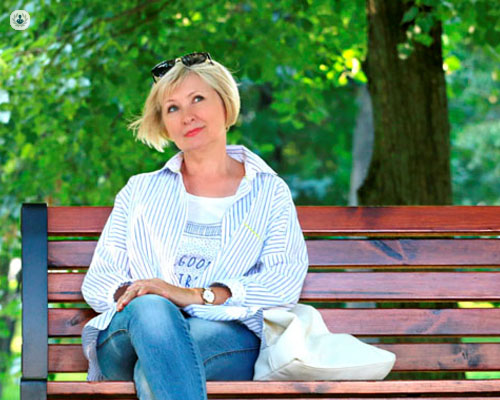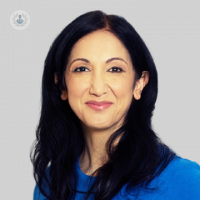Osteoporosis: prevention, risks, and treatments
Written in association with:Osteoporosis is a condition that affects the bones, causing them to become less dense, fragile, and more prone to fractures. Bone is a living tissue that constantly undergoes a natural process of breakdown and renewal. However, osteoporosis develops when the creation of new bone cannot keep up with the removal of old bone. Over time, this imbalance results in bones that are weaker and more susceptible to breaks.
Revered consultant rheumatologist Dr Israa Al-Shakarchi provides a guide to the condition.

How does osteoporosis manifest?
This condition doesn’t manifest overnight. Instead, it progresses silently over several years without causing noticeable symptoms until a minor incident, such as a fall, leads to a fracture. This stealthy nature has earned osteoporosis the nickname ‘the silent thief.’ Many individuals are unaware of their bone deterioration until they experience one or more fractures. In fact, about 20% of women who suffer a fracture will have multiple fractures before receiving a diagnosis. Common fracture sites include the wrists, hips, and spine, but other bones can also be affected.
Who is affected by osteoporosis?
Osteoporosis primarily affects women, with nearly three million cases reported in the UK alone, representing 78% of all osteoporosis patients. A significant increase in risk occurs after menopause due to the sharp decline in oestrogen levels, a hormone essential for bone health. Women who experience early menopause (before the age of 45) or have their ovaries surgically removed face an even greater risk.
While women are more commonly affected, men are not immune. Osteoporosis in men is often linked to low testosterone levels, although the cause may sometimes remain unclear. For both sexes, the likelihood of developing osteoporosis increases with age. In women, the prevalence of the condition rises from approximately 2% at age 50 to nearly 50% by the age of 80.
What causes osteoporosis?
Although losing some bone density is a natural part of aging for both men and women, certain factors can accelerate this process, leading to osteoporosis. These risk factors include:
- Hormonal changes: A major risk factor for women is menopause, especially if it occurs early or involves ovary removal. For men, low testosterone levels can contribute.
- Family history: A family history of osteoporosis, particularly hip fractures in parents, increases risk.
- Medical conditions: Conditions like inflammatory arthritis, inflammatory bowel disease, overactive thyroid or parathyroid glands, Type 1 diabetes, Cushing’s syndrome, coeliac disease, and chronic kidney or liver disease are associated with higher osteoporosis risk.
- Medications: Long-term use of high-dose steroids (e.g., Prednisolone), some cancer treatments, epilepsy drugs, and certain medications for reflux disease can weaken bones.
- Eating disorders: Conditions like anorexia or bulimia can severely impact bone health.
- Low body mass index (BMI): Being underweight (BMI below 18.5) increases the likelihood of bone loss.
- Poor nutrition: Diets deficient in calcium and vitamin D contribute to weaker bones.
- Physical factors: A small, thin build or long periods of inactivity, such as bed rest, can increase vulnerability.
- Lifestyle choices: Excessive alcohol consumption (over three units daily) and smoking negatively affect bone health.
- Ethnicity: Osteoporosis is more prevalent in Caucasian and Asian populations.
Strengthening bones and reducing fracture risk
Several lifestyle changes can improve bone health and reduce the likelihood of fractures. These include:
- Eating a balanced diet:
- Calcium: Aim for 1,000-1,500 mg daily. Sources include dairy products, leafy greens, tofu, fortified cereals, dried fruits, and fish with bones (e.g., sardines).
- Vitamin D: Adults need 600-800 IU (15-20 mcg) per day. Foods rich in vitamin D include oily fish, red meat, egg yolks, and fortified cereals or milk.
- Limiting alcohol:
- Reduce alcohol intake to fewer than 14 units per week and avoid binge drinking, as long-term alcohol consumption reduces bone density and increases fracture risk.
- Quitting smoking:
- Smoking slows the production of bone-forming cells and reduces calcium absorption, leading to weaker bones.
- Engaging in regular exercise:
- Perform weight-bearing activities (e.g., walking, running), muscle-strengthening exercises (e.g., cycling, swimming), resistance training, and balance exercises (e.g., tai chi).
- Minimising hazards:
- Remove clutter, ensure proper lighting, and address sensory impairments to reduce the risk of falls at home.
Can osteoporosis be cured?
Unfortunately, osteoporosis cannot be cured but it can be effectively managed. Treatment focuses on preventing fractures and strengthening bones through a combination of lifestyle changes and medications. Common drug treatments include:
- Bisphosphonates: Reduce bone breakdown and fracture risk.
- Selective oestrogen receptor modulators (SERMs): Preserve bone density, particularly in the spine.
- Parathyroid hormone treatments: Promote new bone growth.
- Biological medicines: Slow bone breakdown and encourage bone formation (e.g., Denosumab, Romosozumab).
- Calcium and vitamin D supplements: Support overall bone health.
- Hormone replacement therapy (HRT): Helps maintain bone density and reduce fracture risk in women.
The future of osteoporosis care
As life expectancy increases globally, the prevalence of osteoporosis is expected to rise significantly. This highlights the importance of early diagnosis and proactive management. Advancements in diagnostic tools, innovative treatments, and emerging strategies hold promise for improved care and outcomes for individuals with osteoporosis.
By understanding osteoporosis, recognising risk factors, and adopting preventive measures, you can take control of your bone health and reduce the risk of fractures. If you have concerns about your bone health, schedule an appointment with an experienced rheumatologist for personalised advice and care.
If you are concerned about osteoporosis and would like to book a consultation with Dr Al-Shakarchi, do not hesitate to do so by visiting her Top Doctors profile today.


